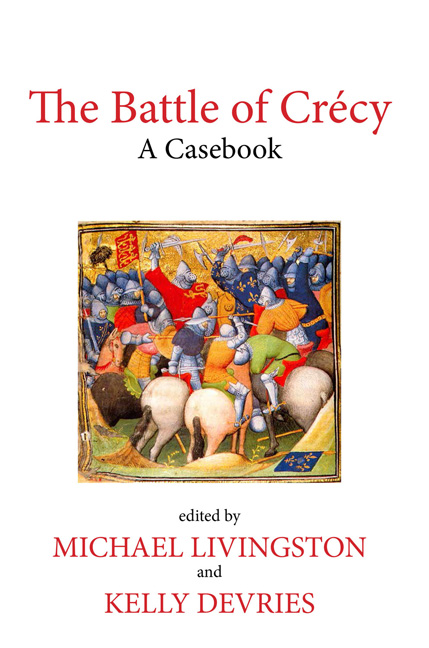Book contents
- Frontmatter
- Contents
- ILLUSTRATIONS
- CONTRIBUTORS
- PREFACE: THE SHAPE OF THE VOLUME
- MAP OF THE CRÉCY CAMPAIGN
- LOSSES UNCOUNTABLE: THE CONTEXT OF CRÉCY
- SOURCES ON THE BATTLE
- NOTES TO THE TEXTS
- ESSAYS ON THE BATTLE
- THE LOCATION OF THE BATTLE OF CRÉCY
- THE BOHEMIAN PARTICIPATION IN CRÉCY
- THE GENOESE CROSSBOWMEN AT CRÉCY
- THE TACTICS OF CRÉCY
- FROISSART'S HERCE AND CRÉCY
- THE ITALIAN PERSPECTIVE ON CRÉCY
- COUNTING THE DEAD AT CRÉCY
- THE AFTER-LIFE OF CRÉCY
- BIBLIOGRAPHY
- INDEX TO THE VOLUME
FROISSART'S HERCE AND CRÉCY
- Frontmatter
- Contents
- ILLUSTRATIONS
- CONTRIBUTORS
- PREFACE: THE SHAPE OF THE VOLUME
- MAP OF THE CRÉCY CAMPAIGN
- LOSSES UNCOUNTABLE: THE CONTEXT OF CRÉCY
- SOURCES ON THE BATTLE
- NOTES TO THE TEXTS
- ESSAYS ON THE BATTLE
- THE LOCATION OF THE BATTLE OF CRÉCY
- THE BOHEMIAN PARTICIPATION IN CRÉCY
- THE GENOESE CROSSBOWMEN AT CRÉCY
- THE TACTICS OF CRÉCY
- FROISSART'S HERCE AND CRÉCY
- THE ITALIAN PERSPECTIVE ON CRÉCY
- COUNTING THE DEAD AT CRÉCY
- THE AFTER-LIFE OF CRÉCY
- BIBLIOGRAPHY
- INDEX TO THE VOLUME
Summary
Without a doubt Jean Froissart is the single most cited medieval source on the Battle of Crécy — even though many of his writings post-date the engagement itself by roughly half a century. There is good reason for this, however: Froissart is a lucid and engaging writer, one who presents history not as a simple account of facts but as a story told with presumed authority and full of vibrant characters and interesting details. Froissart is simply easy to believe.
Yet even if one does believe Froissart's words, there is always the frustrating problem of what those words actually mean, especially some of the less frequent, more technical words. Nowhere is this more apparent than in trying to determine what Froissart intends when he has English archers at Crécy placed in the manner of a herce — a word that has also now been found as a place name on the newly proposed battlefield.
It should first be pointed out that Froissart was hardly alone in being intrigued by the fourteenth-century changes in warfare brought about by new military technology. His interest in longbow archery in particular — and how it seemed to have at least improved English fighting capabilities, if not at times determined victory — is so great that he frequently singles out the performance of the English longbowmen, despite their socio-economic differences from the men-at-arms and knights who are the focus of most of his writing.
In most of these engagements, Froissart gives few details about the archers, their recruitment and organization, or their bows. General descriptions are sometimes provided for the result of the archery shot (such as “the archers shot well”) or rate of shot (“they shot quickly”), and, at times, Froissart is certain to place the English archers on the flanks, in the vanguard, and on shipboard.
At Crécy, Froissart writes that the longbowmen initiated the killing by shooting against the approaching Genoese crossbowmen. Before the latter could set themselves and discharge their own missile weapons,
when the English archers saw what was happening, they moved forward a bit and then made their arrows rain down on the Genoese so effectively and in such quick succession that it seemed like snow.
- Type
- Chapter
- Information
- The Battle of CrécyA Casebook, pp. 469 - 476Publisher: Liverpool University PressPrint publication year: 2015



